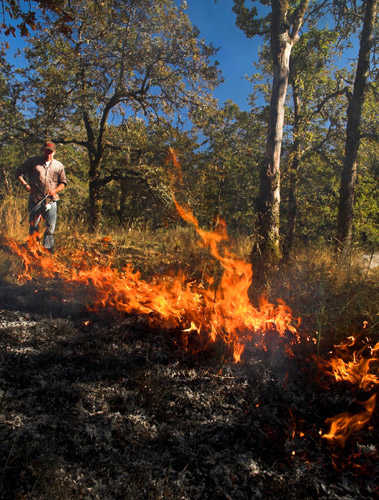
Mention carbon sequestration, and many people might think of pumping global-warming gases into depleted oil reservoirs in Western Canada. Prof. Andrew MacDougall, Integrative Biology, has a different form of sequestration in mind – one that might also help restore some of southern Ontario’s native prairie long lost to farms and cities.
To see what he means, visit his outdoor research lab located not on the U of G campus but in Cambridge. Near the meeting place of the Grand and Speed rivers, MacDougall has planted an 18-hectare prairie this spring on a former soybean field.
He’ll watch what happens over the next decade as various tallgrass species root themselves in the flats directly south of the Grand River. Then he’ll burn parts of the plot to mimic the natural rhythm of regeneration in the prairie lands that once covered portions of southern Ontario.
Prairie in Ontario? MacDougall says it surprises many people to learn that at least 100,000 hectares of the province were covered by grasslands as recently as 200 years ago. Only a few sites remain, scattered between Windsor and Belleville. “Through time, people have forgotten we had prairie.”
That means that plants and animals normally found in these sites are also uncommon. About one in five of Ontario’s rare plants are prairie species, including Culver’s root, tall ironweed and prairie rose, according to Tallgrass Ontario. That organization was formed in 1999 to help restore habitat for tallgrass as well as savannah, or mixed prairie and trees.
The Guelph professor hopes his study might help in that effort.
He’s looking at factors affecting prairie restoration, including how tallgrass species resist invasion from exotic agronomic grasses and how various species distribute themselves within the prairie. He also hopes to see his research site become a self-sustaining prairie, including attracting birds, mammals and insects.
Looking for a space that was large enough and that could accommodate periodic burning typical of prairie vegetation, MacDougall found the Rare Charitable Research Reserve in Cambridge. He’s now one of several Guelph botanists and ecologists running research projects at this 370-hectare nature reserve that includes a remnant old-growth forest.
MacDougall plans to monitor how his plants take in carbon from the air and store it in their roots and ultimately in soil. Likening a prairie swath to an iceberg, he says, “Ninety per cent of the activity is below ground.”
More important, scientists believe native grassland species are more efficient at sequestering carbon than introduced crop plants and pasture grasses. One study in Saskatchewan a decade ago found that native prairie stored 25 per cent more carbon underground than grasses introduced for cattle forage. The latter now cover 10 million hectares of the northern Great Plains.
“One of the biggest effluxes of atmospheric carbon dioxide over the last 200 years has been the breaking of the native prairie. Their distribution across North America was massive, covering about 25 per cent of the entire continent.”
He’s not proposing to revert entirely to grasslands, of course, but suggests we might find a different balance between farming and conservation. Perhaps farmers and other landowners can gain carbon credits for planting prairies, he says.
Other – perhaps better — ideas exist for sequestering carbon, MacDougall says. But he points to the ecological benefits of grasslands, including providing habitat for pollinating species and maintaining diversity of plants and animals, many of them endangered. “It’s not just about carbon but restoring wildlife.”
Originally from the Maritimes, he worked in Australia before returning to Canada. Besides his new Cambridge site, he’s working on oak savannah grasslands owned by the Nature Conservancy of Canada on Vancouver Island and mixed-grass prairie with collaborators in Saskatchewan and Montana.
His own front garden in Guelph boasts a small tallgrass prairie, including species that that attract birds and butterflies.